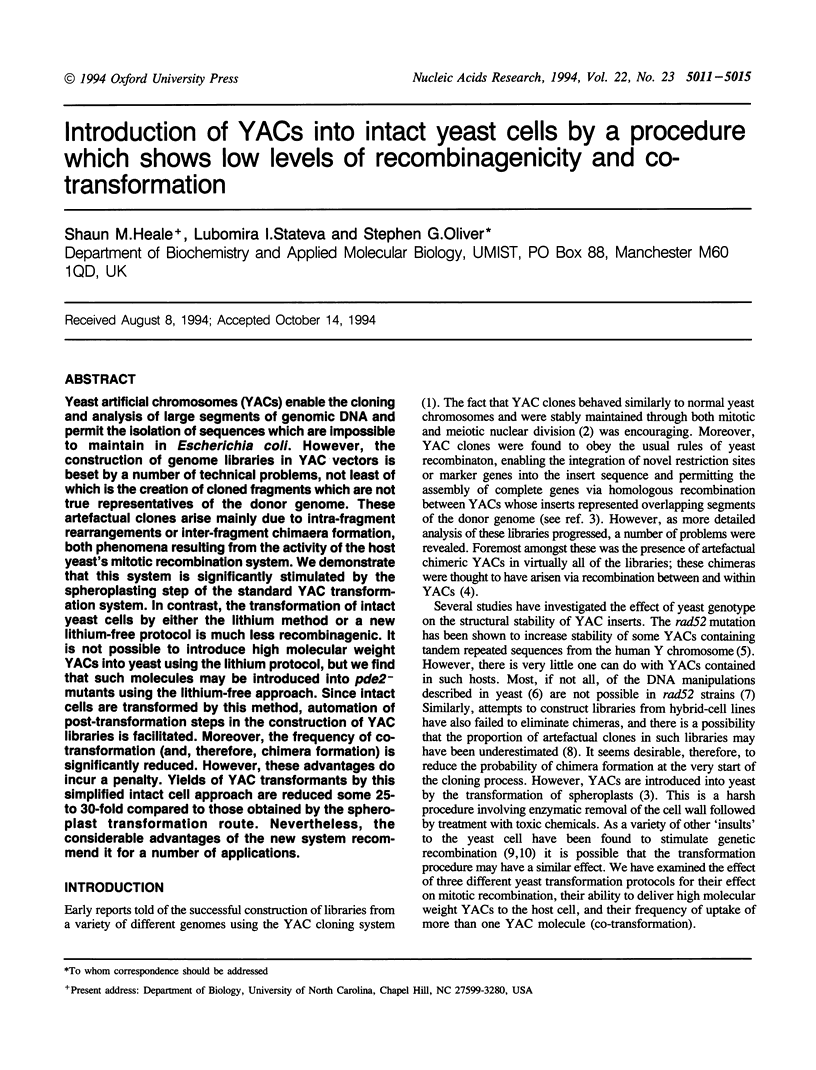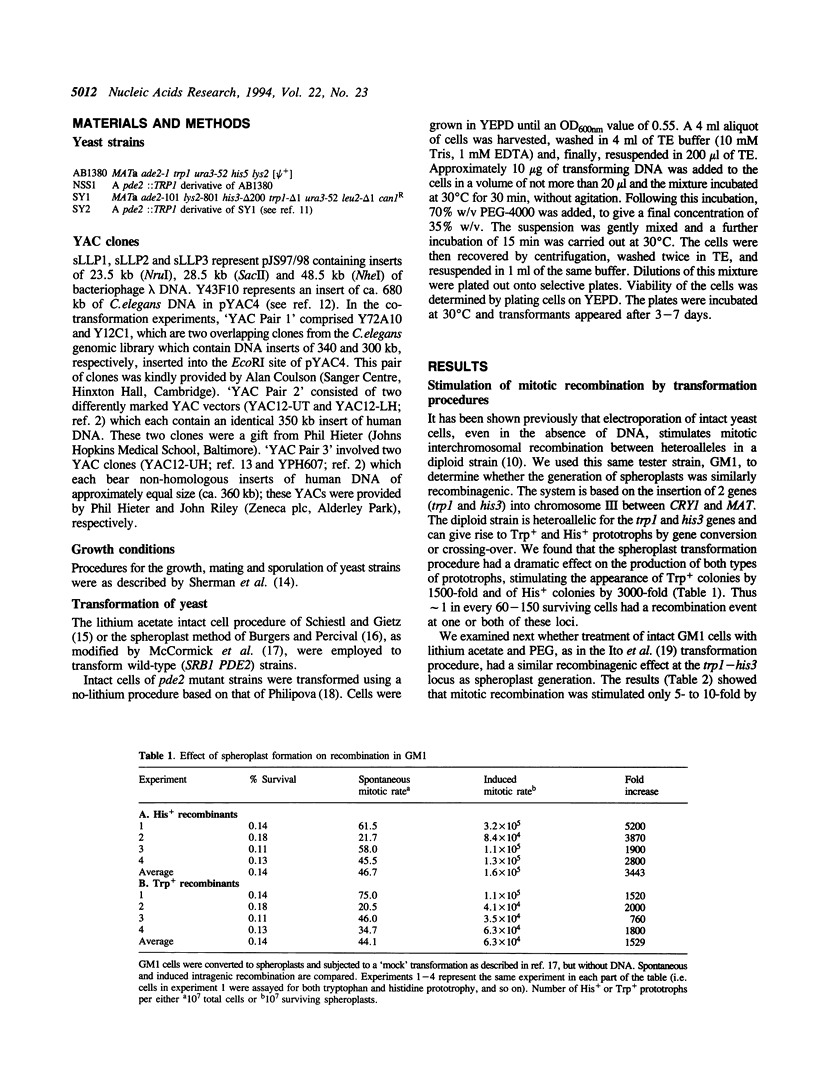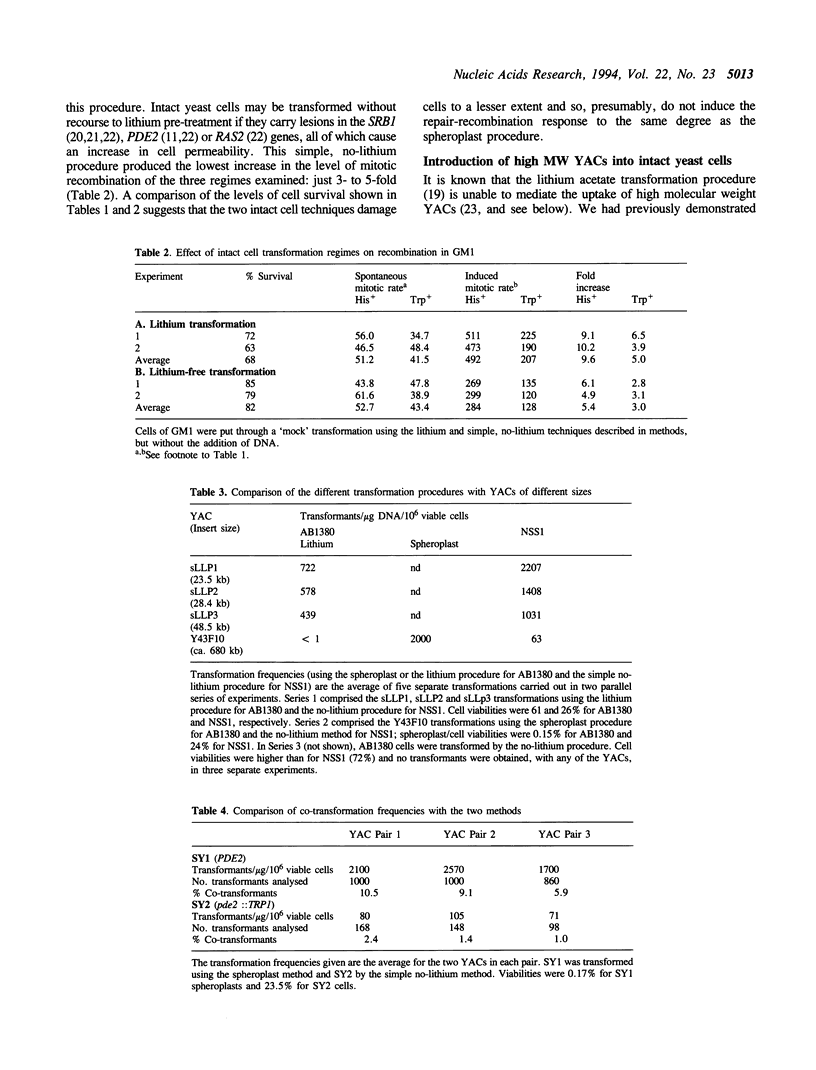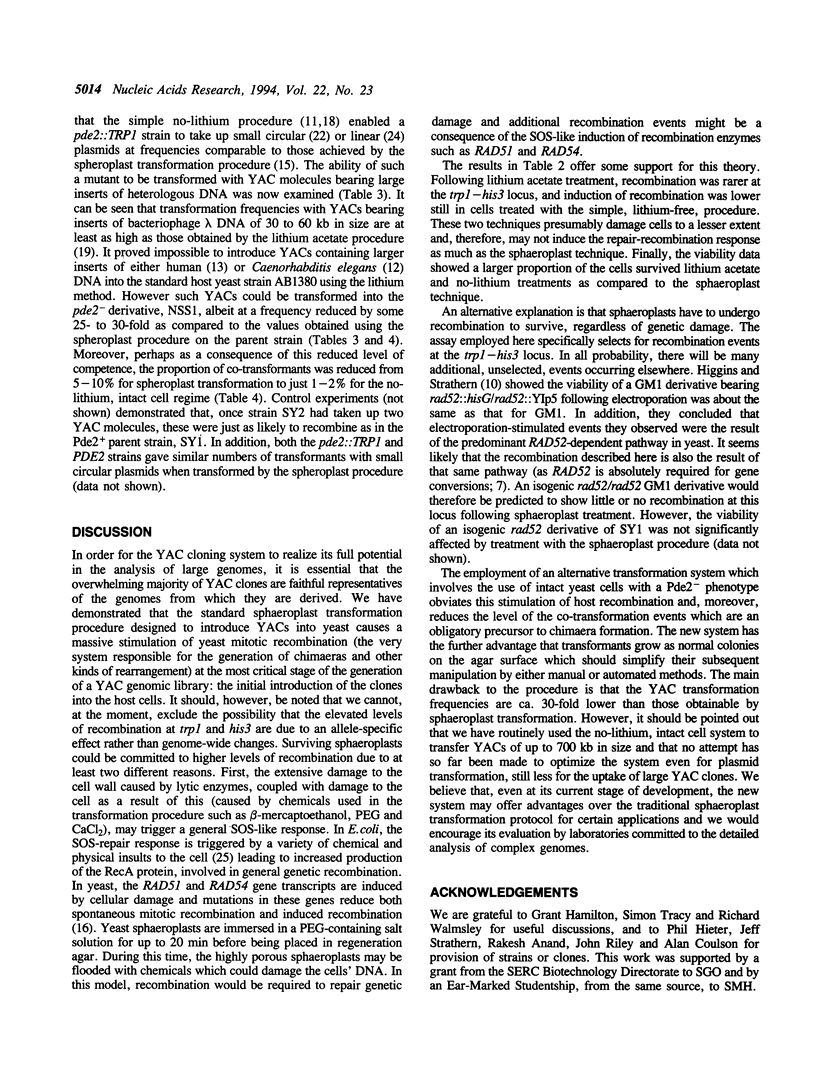Abstract
Yeast artificial chromosomes (YACs) enable the cloning and analysis of large segments of genomic DNA and permit the isolation of sequences which are impossible to maintain in Escherichia coli. However, the construction of genome libraries in YAC vectors is beset by a number of technical problems, not least of which is the creation of cloned fragments which are not true representatives of the donor genome. These artefactual clones arise mainly due to intra-fragment rearrangements or inter-fragment chimaera formation, both phenomena resulting from the activity of the host yeast's mitotic recombination system. We demonstrate that this system is significantly stimulated by the spheroplasting step of the standard YAC transformation system. In contrast, the transformation of intact yeast cells by either the lithium method or a new lithium-free protocol is much less recombinagenic. It is not possible to introduce high molecular weight YACs into yeast using the lithium protocol, but we find that such molecules may be introduced into pde2-mutants using the lithium-free approach. Since intact cells are transformed by this method, automation of post-transformation steps in the construction of YAC libraries is facilitated. Moreover, the frequency of cotransformation (and, therefore, chimera formation) is significantly reduced. However, these advantages do incur a penalty. Yields of YAC transformants by this simplified intact cell approach are reduced some 25- to 30-fold compared to those obtained by the spheroplast transformation route. Nevertheless, the considerable advantages of the new system recommend it for a number of applications.
Full text
PDF




Selected References
These references are in PubMed. This may not be the complete list of references from this article.
- Anand R., Villasante A., Tyler-Smith C. Construction of yeast artificial chromosome libraries with large inserts using fractionation by pulsed-field gel electrophoresis. Nucleic Acids Res. 1989 May 11;17(9):3425–3433. doi: 10.1093/nar/17.9.3425. [DOI] [PMC free article] [PubMed] [Google Scholar]
- Burgers P. M., Percival K. J. Transformation of yeast spheroplasts without cell fusion. Anal Biochem. 1987 Jun;163(2):391–397. doi: 10.1016/0003-2697(87)90240-5. [DOI] [PubMed] [Google Scholar]
- Burke D. T., Olson M. V. Preparation of clone libraries in yeast artificial-chromosome vectors. Methods Enzymol. 1991;194:251–270. doi: 10.1016/0076-6879(91)94020-d. [DOI] [PubMed] [Google Scholar]
- Coulson A., Waterston R., Kiff J., Sulston J., Kohara Y. Genome linking with yeast artificial chromosomes. Nature. 1988 Sep 8;335(6186):184–186. doi: 10.1038/335184a0. [DOI] [PubMed] [Google Scholar]
- Green E. D., Riethman H. C., Dutchik J. E., Olson M. V. Detection and characterization of chimeric yeast artificial-chromosome clones. Genomics. 1991 Nov;11(3):658–669. doi: 10.1016/0888-7543(91)90073-n. [DOI] [PubMed] [Google Scholar]
- Higgins D. R., Strathern J. N. Electroporation-stimulated recombination in yeast. Yeast. 1991 Nov;7(8):823–831. doi: 10.1002/yea.320070807. [DOI] [PubMed] [Google Scholar]
- Ito H., Fukuda Y., Murata K., Kimura A. Transformation of intact yeast cells treated with alkali cations. J Bacteriol. 1983 Jan;153(1):163–168. doi: 10.1128/jb.153.1.163-168.1983. [DOI] [PMC free article] [PubMed] [Google Scholar]
- Kozhina T., Stateva L., Venkov P. Genetic analysis of an osmotic sensitive Saccharomyces cerevisiae mutant. Mol Gen Genet. 1979 Mar 5;170(3):351–354. doi: 10.1007/BF00267069. [DOI] [PubMed] [Google Scholar]
- Little J. W., Mount D. W. The SOS regulatory system of Escherichia coli. Cell. 1982 May;29(1):11–22. doi: 10.1016/0092-8674(82)90085-x. [DOI] [PubMed] [Google Scholar]
- Little R. D., Pilia G., Johnson S., D'Urso M., Schlessinger D. Yeast artificial chromosomes spanning 8 megabases and 10-15 centimorgans of human cytogenetic band Xq26. Proc Natl Acad Sci U S A. 1992 Jan 1;89(1):177–181. doi: 10.1073/pnas.89.1.177. [DOI] [PMC free article] [PubMed] [Google Scholar]
- McCormick M. K., Shero J. H., Cheung M. C., Kan Y. W., Hieter P. A., Antonarakis S. E. Construction of human chromosome 21-specific yeast artificial chromosomes. Proc Natl Acad Sci U S A. 1989 Dec;86(24):9991–9995. doi: 10.1073/pnas.86.24.9991. [DOI] [PMC free article] [PubMed] [Google Scholar]
- Neil D. L., Villasante A., Fisher R. B., Vetrie D., Cox B., Tyler-Smith C. Structural instability of human tandemly repeated DNA sequences cloned in yeast artificial chromosome vectors. Nucleic Acids Res. 1990 Mar 25;18(6):1421–1428. doi: 10.1093/nar/18.6.1421. [DOI] [PMC free article] [PubMed] [Google Scholar]
- Rothstein R. Targeting, disruption, replacement, and allele rescue: integrative DNA transformation in yeast. Methods Enzymol. 1991;194:281–301. doi: 10.1016/0076-6879(91)94022-5. [DOI] [PubMed] [Google Scholar]
- Sears D. D., Hegemann J. H., Hieter P. Meiotic recombination and segregation of human-derived artificial chromosomes in Saccharomyces cerevisiae. Proc Natl Acad Sci U S A. 1992 Jun 15;89(12):5296–5300. doi: 10.1073/pnas.89.12.5296. [DOI] [PMC free article] [PubMed] [Google Scholar]
- Selleri L., Eubanks J. H., Giovannini M., Hermanson G. G., Romo A., Djabali M., Maurer S., McElligott D. L., Smith M. W., Evans G. A. Detection and characterization of "chimeric" yeast artificial chromosome clones by fluorescent in situ suppression hybridization. Genomics. 1992 Oct;14(2):536–541. doi: 10.1016/s0888-7543(05)80263-0. [DOI] [PubMed] [Google Scholar]
- Stateva L. I., Oliver S. G., Trueman L. J., Venkov P. V. Cloning and characterization of a gene which determines osmotic stability in Saccharomyces cerevisiae. Mol Cell Biol. 1991 Aug;11(8):4235–4243. doi: 10.1128/mcb.11.8.4235. [DOI] [PMC free article] [PubMed] [Google Scholar]
- Venkov P. V., Hadjiolov A. A., Battaner E., Schlessinger D. Saccharomyces cerevisiae: sorbitol-dependent fragile mutants. Biochem Biophys Res Commun. 1974 Feb 4;56(3):599–604. doi: 10.1016/0006-291x(74)90646-9. [DOI] [PubMed] [Google Scholar]
- Zhou Z., Elledge S. J. DUN1 encodes a protein kinase that controls the DNA damage response in yeast. Cell. 1993 Dec 17;75(6):1119–1127. doi: 10.1016/0092-8674(93)90321-g. [DOI] [PubMed] [Google Scholar]


